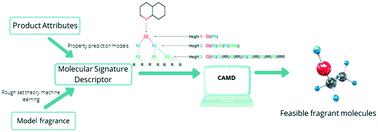当前位置:
X-MOL 学术
›
Mol. Syst. Des. Eng.
›
论文详情
Our official English website, www.x-mol.net, welcomes your feedback! (Note: you will need to create a separate account there.)
Design of fragrant molecules through the incorporation of rough sets into computer-aided molecular design
Molecular Systems Design & Engineering ( IF 3.6 ) Pub Date : 2020-08-04 , DOI: 10.1039/d0me00067a Kirridharhapany T. Radhakrishnapany 1, 2, 3 , Chee Yan Wong 1, 2, 3 , Fang Khai Tan 1, 2, 3 , Jia Wen Chong 1, 2, 3 , Raymond R. Tan 4, 5, 6, 7 , Kathleen B. Aviso 4, 5, 6, 7 , Jose Isagani B. Janairo 5, 6, 7, 8 , Nishanth G. Chemmangattuvalappil 1, 2, 3
Molecular Systems Design & Engineering ( IF 3.6 ) Pub Date : 2020-08-04 , DOI: 10.1039/d0me00067a Kirridharhapany T. Radhakrishnapany 1, 2, 3 , Chee Yan Wong 1, 2, 3 , Fang Khai Tan 1, 2, 3 , Jia Wen Chong 1, 2, 3 , Raymond R. Tan 4, 5, 6, 7 , Kathleen B. Aviso 4, 5, 6, 7 , Jose Isagani B. Janairo 5, 6, 7, 8 , Nishanth G. Chemmangattuvalappil 1, 2, 3
Affiliation

|
Design and screening of fragrances based on experiments or experiences of specialists can overlook potentially better fragrance products. To overcome this issue, a systematic mathematical programming-based approach is developed for the design of fragrant molecules. A novel data-driven rough set-based machine learning (RSML) model is utilised as a predictive or diagnostic modelling tool for odour properties. RSML generates deterministic rules based on the relationship between the topology of fragrant molecules and their odour characters elicited from an existing odour database. The rules generated are then integrated as constraints into a computer-aided molecular design (CAMD) problem. The CAMD framework also involves other relevant properties such as diffusion coefficient, vapour pressure, viscosity, LC50 and solubility parameter which are predicted using a group contribution (GC) method. Since there are different types of models involved in the prediction of various attributes, molecular signature descriptors are utilised as the common platform that links machine learning and other predictive models in a CAMD problem. The application of the new design method is demonstrated through a case study to design fragrant molecules for shampoo additives with desirable physical and environmental properties. The results indicate the ability of the novel method in identifying non-intuitive and promising fragrant molecules that can be used for various applications.
中文翻译:

通过将粗糙集纳入计算机辅助分子设计中来设计香气分子
根据专家的实验或经验设计和筛选香精可能会忽略潜在的更好的香精产品。为了克服这个问题,开发了一种基于系统数学编程的方法来设计芳香分子。一种新颖的数据驱动的基于粗糙集的机器学习(RSML)模型被用作气味特性的预测或诊断建模工具。RSML根据芳香分子的拓扑结构与从现有气味数据库中得出的气味特征之间的关系生成确定性规则。然后将生成的规则作为约束条件集成到计算机辅助分子设计(CAMD)问题中。CAMD框架还涉及其他相关属性,例如扩散系数,蒸气压,粘度,LC 50和溶解度参数是使用基团贡献(GC)方法预测的。由于在各种属性的预测中涉及不同类型的模型,因此将分子标记描述符用作链接机器学习和CAMD问题中其他预测模型的通用平台。通过案例研究证明了这种新设计方法的应用,以设计具有所需物理和环境特性的香波添加剂香气分子。结果表明,该新方法具有识别可用于各种应用的非直观和有希望的芳香分子的能力。
更新日期:2020-09-28
中文翻译:

通过将粗糙集纳入计算机辅助分子设计中来设计香气分子
根据专家的实验或经验设计和筛选香精可能会忽略潜在的更好的香精产品。为了克服这个问题,开发了一种基于系统数学编程的方法来设计芳香分子。一种新颖的数据驱动的基于粗糙集的机器学习(RSML)模型被用作气味特性的预测或诊断建模工具。RSML根据芳香分子的拓扑结构与从现有气味数据库中得出的气味特征之间的关系生成确定性规则。然后将生成的规则作为约束条件集成到计算机辅助分子设计(CAMD)问题中。CAMD框架还涉及其他相关属性,例如扩散系数,蒸气压,粘度,LC 50和溶解度参数是使用基团贡献(GC)方法预测的。由于在各种属性的预测中涉及不同类型的模型,因此将分子标记描述符用作链接机器学习和CAMD问题中其他预测模型的通用平台。通过案例研究证明了这种新设计方法的应用,以设计具有所需物理和环境特性的香波添加剂香气分子。结果表明,该新方法具有识别可用于各种应用的非直观和有希望的芳香分子的能力。



























 京公网安备 11010802027423号
京公网安备 11010802027423号